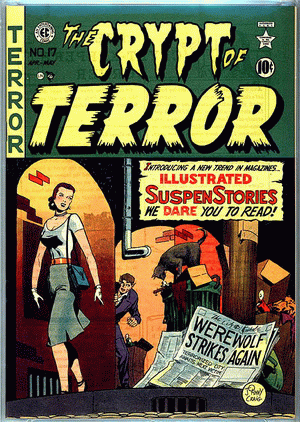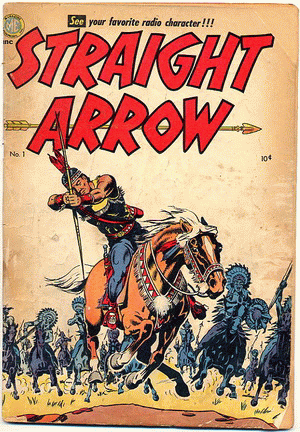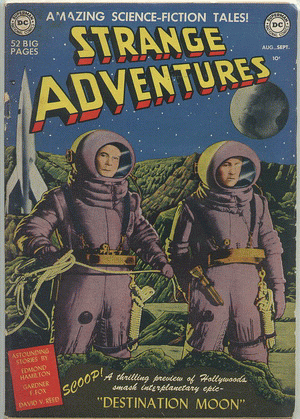Newsstand Period 1922 - 1955
 1950 was the year the horror genre began in earnest. In April of
that year a publisher called EC put out 3 new horror titles. They
advertised them with the slogan "Introducing a New Trend in Magazines.
Illustrated Suspenstories we dare you to read!" The titles and issues
were Crypt of Terror #17, Vault of Horror #12,
and Haunt of Fear
#15. Today they are collectively known as the "New Trend" titles. These
titles pulled no punches in showing injuries of all types, murders, or
corpses coming back from the dead for revenge. The stories had twist
endings and featured ghastly hosts that told gruesome puns. The artwork
was done by greats such as Jack Davis, Graham Ingles and Johnny Craig.
Writer / Artist / Editor Al Feldstein did the stories and owner William
Gaines would come up with "springboard" ideas - plots from books he read the night before.
Among the early stories were adaptations of Edgar Alan Poe works.
These comics would later be the source material for a TV show
called Tales from the Crypt. They would also be enjoyed by a young
Stephen King. One of his early novels to be adapted into a movie was
called Creepshow, where the EC style is very pronounced. It should be
said that Jack Davis had much success outside of comics in advertising art. Among his better known
works would be the long running animated RAID Bugs commercials.
1950 was the year the horror genre began in earnest. In April of
that year a publisher called EC put out 3 new horror titles. They
advertised them with the slogan "Introducing a New Trend in Magazines.
Illustrated Suspenstories we dare you to read!" The titles and issues
were Crypt of Terror #17, Vault of Horror #12,
and Haunt of Fear
#15. Today they are collectively known as the "New Trend" titles. These
titles pulled no punches in showing injuries of all types, murders, or
corpses coming back from the dead for revenge. The stories had twist
endings and featured ghastly hosts that told gruesome puns. The artwork
was done by greats such as Jack Davis, Graham Ingles and Johnny Craig.
Writer / Artist / Editor Al Feldstein did the stories and owner William
Gaines would come up with "springboard" ideas - plots from books he read the night before.
Among the early stories were adaptations of Edgar Alan Poe works.
These comics would later be the source material for a TV show
called Tales from the Crypt. They would also be enjoyed by a young
Stephen King. One of his early novels to be adapted into a movie was
called Creepshow, where the EC style is very pronounced. It should be
said that Jack Davis had much success outside of comics in advertising art. Among his better known
works would be the long running animated RAID Bugs commercials.
 EC comics would follow up their New Trend books with
Crime SuspenStories #1 in October. While this title was still horror, it had more to do with humans
murdering each other instead of the supernatural. As a result this title became a focal point
during the U.S. Senate Hearings against investigating Comic Books and Juvenile Delinquency.
This was mainly due to a
shocking cover with a man holding a bloody axe in one hand, and a
severed woman’s head in the other (Crime SuspenStories #22). Publisher William Gaines was
asked on national TV if the comic book cover was in good taste. Gaines responded "Yes sir, I do...for
the cover of a horror comic. A cover in bad taste, for example, might be defined as holding the head
a little higher so that the neck could be seen to be dripping blood from it, and moving the body over
a little further so that the neck of the body could be seen to be bloody." This answer did not go over
well with the government or the public.
EC comics would follow up their New Trend books with
Crime SuspenStories #1 in October. While this title was still horror, it had more to do with humans
murdering each other instead of the supernatural. As a result this title became a focal point
during the U.S. Senate Hearings against investigating Comic Books and Juvenile Delinquency.
This was mainly due to a
shocking cover with a man holding a bloody axe in one hand, and a
severed woman’s head in the other (Crime SuspenStories #22). Publisher William Gaines was
asked on national TV if the comic book cover was in good taste. Gaines responded "Yes sir, I do...for
the cover of a horror comic. A cover in bad taste, for example, might be defined as holding the head
a little higher so that the neck could be seen to be dripping blood from it, and moving the body over
a little further so that the neck of the body could be seen to be bloody." This answer did not go over
well with the government or the public.
Behind the Scenes - No good deed goes unpunished.
When Gaines described how the Crime Suspenstories #22 cover could
be in bad taste, he was actually describing the original version of the cover drawn by Johnny Craig!
Gaines had it toned down to the version shown above.
 EC didn't just do horror comics, among the other genres they dabbled in
was Science Fiction. Two of those titles were Weird Fantasy (#13) and
Weird Science (#12). They
were published in May-June of 1950. Among the earliest stories were plagiarized from popular writer
Ray Bradbury, whom was paid after he got in contact with EC Comics. The two would
soon strike an agreement and EC would publish more adaptations of his
work. These titles had a number of influential talent working on them.
One of them being Wally Wood, who preferred to be called his nick name of
Woody.
EC didn't just do horror comics, among the other genres they dabbled in
was Science Fiction. Two of those titles were Weird Fantasy (#13) and
Weird Science (#12). They
were published in May-June of 1950. Among the earliest stories were plagiarized from popular writer
Ray Bradbury, whom was paid after he got in contact with EC Comics. The two would
soon strike an agreement and EC would publish more adaptations of his
work. These titles had a number of influential talent working on them.
One of them being Wally Wood, who preferred to be called his nick name of
Woody.
Among the best of the stories would be one called Judgement Day
that had a strong anti-racism moral. This story also made waves with the comic censors at the CMAA who
wanted to edit the artwork to tone down the impact of this story. Specifically they wanted to remove
the beads of sweat from a black man who just gets off a planet where one race is subjected to the same
horrible conditions that used to exist for African Americans on Earth. Gaines told the CMAA that he
would publish the story as is, with their seal of approval on it and if they balked he would publicly
accuse them of being racist. The CMAA decided to back off and let the story go through as is. You will
read more about the CMAA and its effect on the comic industry later. Despite the quality of the stories
these comics didn't sell that well. For a short period, EC raised the cover price to 15 cents. Many
complaints came about of them breaking the industry standard of 10 cents and the title soon went back
to that price. EC continued to publish the books at a loss telling critics that EC was proudest of
their Science Fiction titles.
 A spurt of Native American (Indian) themed comic series started around 1950. Magazine Enterprise
would get the rights to the Straight Arrow radio program and do a comic on it. Straight Arrow debuted
February 1950 and go 53 issues ending in 1956. Other early dedicated series would include
Indian Fighter from Youthful Magazine and
Indians by Fiction House, both done in spring of 1950.
Marvel would come out with Apache Kid and Fiction House would do another title called
Long Bow. Among the more politically incorrect titles
would be Redskin and White Indian. Most of these series were very short, lasting a few years at best.
The more successful of these titles would be Indian Chief by Dell. It would start with Four Color
Comics #290 (August 1950), a second issue within Four Color was done then it changed to
Indian Chief by #3 and go 33
issues ending in 1959. The Lone Rangers Companion Tonto also got his own series around this time as
well. It started in January of 1951 and end in 1959 after 33 issues. With the exception of Dinosaur
featuring Turok, Native American characters and titles haven't done well in the comic industry. The
same could be said of almost all minority comic book characters.
A spurt of Native American (Indian) themed comic series started around 1950. Magazine Enterprise
would get the rights to the Straight Arrow radio program and do a comic on it. Straight Arrow debuted
February 1950 and go 53 issues ending in 1956. Other early dedicated series would include
Indian Fighter from Youthful Magazine and
Indians by Fiction House, both done in spring of 1950.
Marvel would come out with Apache Kid and Fiction House would do another title called
Long Bow. Among the more politically incorrect titles
would be Redskin and White Indian. Most of these series were very short, lasting a few years at best.
The more successful of these titles would be Indian Chief by Dell. It would start with Four Color
Comics #290 (August 1950), a second issue within Four Color was done then it changed to
Indian Chief by #3 and go 33
issues ending in 1959. The Lone Rangers Companion Tonto also got his own series around this time as
well. It started in January of 1951 and end in 1959 after 33 issues. With the exception of Dinosaur
featuring Turok, Native American characters and titles haven't done well in the comic industry. The
same could be said of almost all minority comic book characters.
Indians #1 is in the public domain and you can download and read it by clicking here. (27.2 MB - Scanned Paper)
Long Bow #1 is in the public domain and you can download and read it by clicking here. (17.8 MB - Scanned Paper)
White Indian #1 is in the public domain and you can download and read it by clicking here. (15.9 MB - Scanned Paper)
The bulk of White Indian was done by Frank Frazetta. He did comic books for roughly 10 years, but
would later become a very popular and influential fantasy illustrator. Frazetta started in comics at
age 16 assisting John Giunta at the Bernard Baily's comic shop. He made his debut in a 1946 Tally-Ho
Comics. He would continue to work for a variety of publishers at first doing a lot of funny animal
comics. In those stories he would sign the name Fritz, his then nickname. The Walt Disney Studio had
offered him work based on the strength of these books but he
turned them down. Frazetta would move from comics to comic strips. He spent 8 or 9 years ghosting for
Al Capp on Li'l Abner. He also worked on Flash Gordon and a short lived strip
titled Johnny Comet. In the 60s he would paint covers for a variety of publishers, the early ones
being Jim Warrens' comic magazines Creepy, Eerie and Vampirella. He would also work on many book covers
and movie posters. He is best known for his of sword and sorcery work on the Conan the Barbarian
books. Frazetta's work would influence many creative people both in and outside of comics.
Tally-Ho Comics is in the public domain and you can download and read it by clicking here. (19.3 MB - Scanned Paper)
 DC
produced a science fiction title called Strange Adventures in
August. The first issue was a preview of a movie called Destination
Moon and had a photo type cover from that movie. The comic would last until
1973, doing 244 issues featuring a mix of sci-fi and later superheroes.
At no time was there ever one character that dominated the series but
some popular characters did continue over several issues. There was
also no dominate creators on the book either as artists and writers
switched frequently. While this was odd, theme titles would become more
common as time went along.
DC
produced a science fiction title called Strange Adventures in
August. The first issue was a preview of a movie called Destination
Moon and had a photo type cover from that movie. The comic would last until
1973, doing 244 issues featuring a mix of sci-fi and later superheroes.
At no time was there ever one character that dominated the series but
some popular characters did continue over several issues. There was
also no dominate creators on the book either as artists and writers
switched frequently. While this was odd, theme titles would become more
common as time went along.
 1950 was the year the horror genre began in earnest. In April of
that year a publisher called EC put out 3 new horror titles. They
advertised them with the slogan "Introducing a New Trend in Magazines.
Illustrated Suspenstories we dare you to read!" The titles and issues
were Crypt of Terror #17, Vault of Horror #12,
and Haunt of Fear
#15. Today they are collectively known as the "New Trend" titles. These
titles pulled no punches in showing injuries of all types, murders, or
corpses coming back from the dead for revenge. The stories had twist
endings and featured ghastly hosts that told gruesome puns. The artwork
was done by greats such as Jack Davis, Graham Ingles and Johnny Craig.
Writer / Artist / Editor Al Feldstein did the stories and owner William
Gaines would come up with "springboard" ideas - plots from books he read the night before.
Among the early stories were adaptations of Edgar Alan Poe works.
These comics would later be the source material for a TV show
called Tales from the Crypt. They would also be enjoyed by a young
Stephen King. One of his early novels to be adapted into a movie was
called Creepshow, where the EC style is very pronounced. It should be
said that Jack Davis had much success outside of comics in advertising art. Among his better known
works would be the long running animated RAID Bugs commercials.
1950 was the year the horror genre began in earnest. In April of
that year a publisher called EC put out 3 new horror titles. They
advertised them with the slogan "Introducing a New Trend in Magazines.
Illustrated Suspenstories we dare you to read!" The titles and issues
were Crypt of Terror #17, Vault of Horror #12,
and Haunt of Fear
#15. Today they are collectively known as the "New Trend" titles. These
titles pulled no punches in showing injuries of all types, murders, or
corpses coming back from the dead for revenge. The stories had twist
endings and featured ghastly hosts that told gruesome puns. The artwork
was done by greats such as Jack Davis, Graham Ingles and Johnny Craig.
Writer / Artist / Editor Al Feldstein did the stories and owner William
Gaines would come up with "springboard" ideas - plots from books he read the night before.
Among the early stories were adaptations of Edgar Alan Poe works.
These comics would later be the source material for a TV show
called Tales from the Crypt. They would also be enjoyed by a young
Stephen King. One of his early novels to be adapted into a movie was
called Creepshow, where the EC style is very pronounced. It should be
said that Jack Davis had much success outside of comics in advertising art. Among his better known
works would be the long running animated RAID Bugs commercials.



